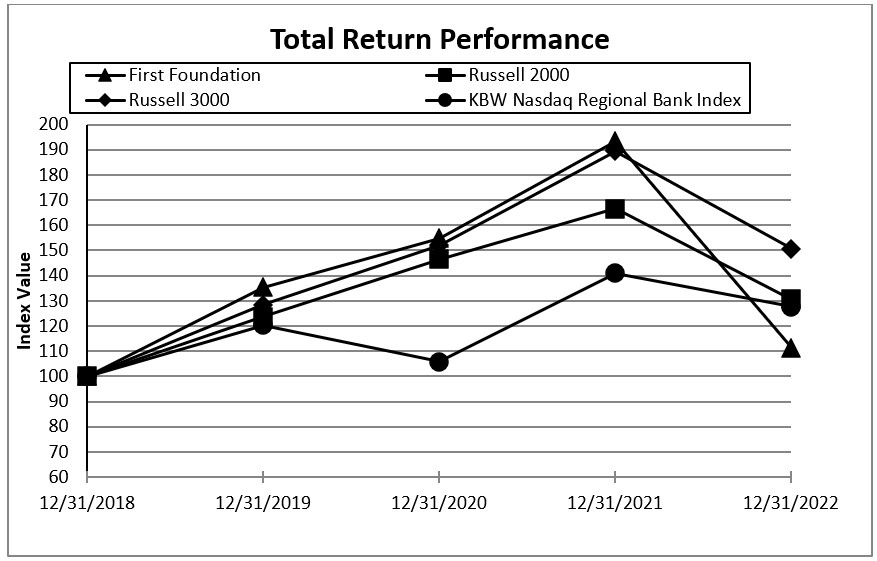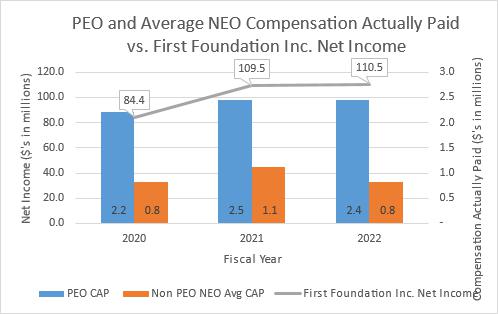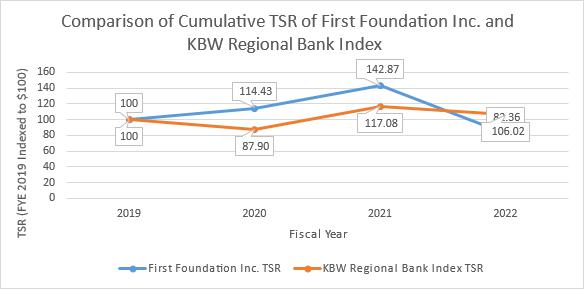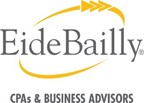Table
| (1) | Although Messrs. Kavanaugh and Keller are also directors of the Company, they do not receive any fees or other compensation for the service as directors. |
| (2) | Ms. Djou received a discretionary annual cash bonus in 2022. |
| (3) | In 2022, 2021 and 2020, each of our NEOs, with the exception of Ms. Djou (who became an NEO in November 2022) received 100% of their target incentive compensation awards. For Mr. Thompson, the amount in 2020 was prorated based on seven months of employment. A portion of each incentive compensation award was paid in RSUs (as further described below), with the remainder paid in cash. |
| (4) | For Mr. Kavanaugh, 30% of his annual incentive award for 2022 was payable to him in the form of RSUs. For Mr. Hakopian, 10% of his annual incentive award for 2022 was payable to him in the form of RSUs. For Mr. Naghibi, 15% of his annual incentive award for 2022 was payable to him in the form of RSUs. For Mr. Keller, 10% of his annual incentive award for 2022 was payable to him in the form of RSUs. Ms. Djou did not receive any RSUs as part of her 2022 annual incentive award. Therefore, on February 28, 2023, Mr. Kavanaugh received a grant of 34,390 RSUs, Mr. Hakopian received a grant of 1,956 RSUs,, Mr. Naghibi received a grant of 4,181 RSUs, and Mr. Keller received a grant of 2,563 RSUs. Our closing price per share on February 28, 2023 was $14.83, which represents the target amount of such annual incentive awards payable in RSUs (which also represents the maximum amount which may be granted in RSU awards under the annual incentive plan). |
For Messrs. Kavanaugh, DePillo and Thompson and Ms. Lawrence, 30% of Contentstheir annual incentive award for 2021 was paid to them in the form of RSUs. For Mr. Keller, 10% of his annual incentive award for 2021 was paid to him in the form of RSUs. Therefore, on February 22, 2022, Mr. Kavanaugh received a grant of 16,503 RSUs, Mr. DePillo received a grant of 10,509 RSUs, Mr. Thompson received a grant of 3,678 RSUs, Ms. Lawrence received a grant of 5,274 RSUs, and Mr. Keller received a grant of 1,326 RSUs. Our closing price per share on February 22, 2022 was $26.36, which represents the target amount of such annual incentive awards payable in RSUs (which also represents the maximum amount which may be granted in RSU awards under the annual incentive plan).
For Mr. Kavanaugh, Mr. DePillo and Ms. Lawrence, 30% of their annual incentive award in 2020 was paid to them in the form of RSUs. Mr. Thompson was awarded a pro-rated incentive award for 2020 for his seven months of employment during 2020, with 30% of such award paid in the form of RSUs. For Mr. Keller, 10% of his annual incentive award for 2020 was paid to him in the form of RSUs. Therefore, on February 23, 2021, Mr. Kavanaugh received a grant of 15,547 RSUs, Mr. DePillo received a grant of 9,765 RSUs, Ms. Lawrence received a grant of 5,868 RSUs, Mr. Thompson received a grant of 2,169 RSUs, and Mr. Keller received a grant of 1,457 RSUs. Our closing price per share on February 23, 2021 was $23.35, which represents the target amount of such annual incentive awards payable in RSUs (which also represents the maximum amount which may be granted in RSU awards under the annual incentive plan).
Each RSU, upon vesting, enables its holder to receive one of our common shares. One-third of these awards of RSUs vested immediately upon the grant date and one-third vests incrementally on each of the first and second anniversaries of the grant date, subject to continued employment.
| (5) | This column reflects the dollar amount of the grant date fair value of an RSU award, computed in accordance with FASB Accounting Standards Codification (“ASC”) Topic 718, Stock Compensation. Generally, the grant date fair value is the amount that we would expense in our financial statements over the award’s vesting schedule. Please see note 14 to our Financial Statements on our Form 10-K for the applicable year for further information. |
| (6) | Ms. Djou received an award of 1,000 RSUs in connection with her appointment as the Interim Chief Financial Officer of FFI and FFB in November 2022. One third of these awards of RSUs vested immediately at the grant date and one-third vests incrementally on each of the first and second anniversaries of the grant date subject to continued employment. |
| (7) | The amounts in this column include Company contributions to the 401(k) of $29,000 for Mr. Kavanaugh, $20,000 for Ms. Djou, $33,000 for Mr. Keller, $34,000 for Mr. Hakopian, $37,000 for Mr. Naghibi, $26,000 for Mr. DePillo, and $29,000 for Ms. Lawrence in 2022; $11,600 for Messrs. Kavanaugh, Thompson, DePillo and Ms. Lawrence, and $7,800 for Mr. Keller in 2021; and $11,400 for Messrs. Kavanaugh, Keller and DePillo and Ms. Lawrence, and $5,200 for Mr. Thompson in 2020. |
| (8) | The amounts in this column include an automobile allowance for Mr. Kavanaugh in 2022, 2021 and 2020, in the amount of $6,000. |
| (9) | Ms. Djou, Mr. Hakopian and Mr. Naghibi were designated as NEOs during 2022 and therefore only 2022 information is included above. |
| (10) | Mr. DePillo resigned from the Company, effective November 7, 2022. Severance payment in the amount of $800,000 was paid to Mr. DePillo on November 25, 2022 and is included in the “All Other Compensation” column above. |
| (11) | Ms. Lawrence resigned from the Company, effective December 2, 2022. Severance payment in the amount of $420,000 was paid to Ms. Lawrence on December 23, 2022 and is included in the “All Other Compensation” column above. |
Employment Agreements
Each of our continuing NEOs is impactedemployed under an employment agreement, with the agreements for Mr. Hakopian ending on December 31, 2023, Ms. Djou ending on December 31, 2024, and Messrs. Kavanaugh, Keller, and Naghibi ending on December 31, 2025. The employment agreements with each NEO are substantially the same, except with respect to compensation amounts.
Mr. Kavanaugh originally entered into an employment agreement with FFI and FFB on September 17, 2007 and this agreement was subsequently amended on December 31, 2009, December 28, 2012, August 31, 2013, January 26, 2016, February 7, 2018, March 11, 2020, and December 5, 2022. Mr. Keller originally entered into an employment agreement with FFA on September 17, 2007 and this agreement was subsequently amended on December 31, 2009, December 31, 2012, August 31, 2013, January 26, 2016, February 7, 2018, March 11, 2020, and December 5, 2022. Ms. Djou entered into an employment agreement with FFB on December 19, 2022. Mr. Hakopian entered into an employment agreement with FFA on December 31, 2009 and this agreement was subsequently amended on December 31, 2012, August 31, 2013, January 26, 2016, March 11, 2020, and December 19, 2022. Mr. Naghibi entered into an employment agreement with FFB on January 1, 2015 and this agreement was subsequently amended on January 26, 2016, February 7, 2018, March 11, 2020, and December 5, 2022. Mr. DePillo entered into an employment agreement with FFB on May 11, 2015 and this agreement was subsequently amended on February 7, 2018 and March 11, 2020. Mr. DePillo resigned in 2022 and his employment agreement was terminated on November 7, 2022. Mr. Thompson entered into an employment agreement with FFB on April 22, 2020. Mr. Thompson resigned in 2022 and his employment agreement was terminated on November 18, 2022. Ms. Lawrence entered into an employment agreement with FFB on June 1, 2015 and this agreement was subsequently amended on February 7, 2018 and March 11, 2020. Ms. Lawrence resigned in 2022 and her employment agreement was terminated on December 2, 2022.
Set forth below are summaries of the material terms of those employment agreements. These summaries are not intended to be complete and are qualified in their entirety by reference to the employment agreements themselves, which are included as exhibits to our Annual Report on Form 10-K filed with the SEC on February 28, 2023.
Material Terms of the Employment Agreements
Salaries. The employment agreements currently provide for the payment of base annual salaries as follows: Mr. Keller: $600,000; Mr. Kavanaugh: $950,000; Ms. Djou: $350,000; Mr. Hakopian: $475,000; and Mr. Naghibi: $420,000. Before Mr. DePillo, Mr. Thompson and Ms. Lawrence left the Company, their employment agreements provided for the payment of base annual salaries of $800,000, $425,000, and $420,000, respectively.
Participation in Incentive Compensation and Employee Benefit Plans. Each of the employment agreements provides that the NEO will be entitled to participate in any management bonus or incentive compensation plans adopted by our Board or our Compensation Committee and in any qualified or any other retirement plans, stock option or equity incentive plans, life, medical and disability insurance plans and other benefit plans which the Company and its subsidiaries may have in effect, from time to time, for all or most of its senior executives.
Termination and Severance Provisions. Each employment agreement provides that the NEO’s employment may be terminated by the volume (changes in volume multipliedCompany with or without cause or due to his or her death or disability or by prior rate), interest rate (changes in rate multiplied by prior volume) and mixthe NEO with or without good reason. In the event of interest-earning assets and interest-bearing liabilities. The following table provides a breakdowntermination of the changesNEO’s employment by the Company without cause or by the NEO for good reason, the Company will become obligated to pay severance compensation to the NEO in net interest incomean amount equal to 12 months of his or her annual base salary or the aggregate annual base salary that would have been paid to the NEO for the remainder of the term of his or her employment agreement if such remaining term is shorter than 12 months (the “Termination Benefits Period”). In addition, during the Termination Benefits Period or until the NEO obtains employment with another employer that offers comparable health insurance benefits, whichever period is shorter, the Company will be obligated to continue to provide any group health plan benefits to the extent authorized by and consistent with 29 U.S.C. § 1161 et seq. (commonly known as “COBRA”), subject to payment of premiums by the NEO at the active employee’s rate then in effect. The severance benefits will be reduced by severance benefits received under other severance or similar plans. Payments of the foregoing severance benefits amounts will be paid over the Termination Benefits Period in pro rata installments in accordance with our payroll practices.
The foregoing severance benefits are subject to the NEO executing an agreement that releases us and our affiliates from all legal claims. The NEO is also required to abide by customary confidentiality provisions and for eighteen months after his or her termination, the NEO may not solicit our employees or use trade secrets or confidential information to solicit current or prospective customers or to encourage customers, suppliers, vendors or service providers to terminate or modify their business relationship with us.
If the NEO’s employment is terminated due to volume and rate changes between 2022his or her death then his or her estate shall receive a lump sum payment equal to his or her then annual base salary with payment occurring as compared to 2021.
| | | | | | | | | |
| | | | | | | | | |
| | | | | | | | | |
| | Increase (Decrease) due to | | Net Increase |
(dollars in thousands) | | Volume | | Rate | | (Decrease) |
Interest earned on: | | | | | | | | | |
Loans | | $ | 132,767 | | $ | 12,488 | | $ | 145,255 |
Securities AFS | | | (10,561) | | | 1,309 | | | (9,252) |
Securities HTM | | | 7,614 | | | 7,614 | | | 15,228 |
Cash, FHLB stock, and fed funds | | | (396) | | | 5,825 | | | 5,429 |
Total interest-earning assets | | | 129,424 | | | 27,236 | | | 156,660 |
Interest paid on: | | | | | | | | | |
Demand deposits | | | 6,207 | | | 15,719 | | | 21,926 |
Money market and savings | | | 1,977 | | | 14,203 | | | 16,180 |
Certificates of deposit | | | 458 | | | 9,828 | | | 10,286 |
Borrowings | | | 17,759 | | | 5,106 | | | 22,865 |
Total interest-bearing liabilities | | | 26,401 | | | 44,856 | | | 71,257 |
Net interest income | | $ | 103,023 | | $ | (17,620) | | $ | 85,403 |
Onsoon as practicable after his or her death. If, during his or her employment, a consolidated basis,NEO experiences a disability such that he or she cannot perform his or her essential job functions then we can only terminate his or her employment after the net interest margin (“NIM”) decreased 24 basis points to 2.91% in 2022 from 3.15% in 2021, as increasesexpiration of the lesser of six months or the remaining term in the yield onemployment agreement. During such period of time, the NEO shall continue to receive his or her annual base salary less any disability or sick pay that he or she is receiving along with continued participation in our employee benefits plans.
Cause/Good Reason Definitions. The employment agreements contain the following definitions with respect to determining whether/when a NEO is eligible for severance benefits.
“Cause” generally means the occurrence of any of the following by the NEO:
acts of gross negligence, willful misconduct or insubordination and which involve us or our affiliates, or acts of fraud;
violation of laws or government regulations which could subject us or our affiliates to disciplinary or enforcement action by a governmental agency, or which could adversely affect our or our affiliates’ reputation or goodwill;
acts which would constitute a felony or any misdemeanor involving moral turpitude, deceit, dishonesty or fraud;
failure to perform a substantial portion of the duties and responsibilities assigned or delegated to the NEO under the employment agreement;
breach of the material obligations under the employment agreement;
violation by the NEO of any conflict of interest bearing deposits exceeded the yield earned on interest earning assets. NIM was also negatively impacted by both increases in the amountpolicy, ethical conduct policy or employment policy or a breach of borrowings as well as the cost of such borrowings. The cost of interest-bearing deposits increased from 0.33% in 2021 to 1.04% in 2022, an increase of 71 basis points, while the yield earned on interest earning assets increased from 3.34% in 2021 to 3.69% in 2022, an increase of 35 basis points. The average rate on borrowings increased from 0.75% in 2021 to 3.09% in 2022, an increase of 234 basis points. The average balance of borrowings outstanding increased $691.3 million from $63.7 million in 2021 to $754.9 million in 2022. The increase in borrowings was due to his or her fiduciary duties;
the issuance of $150 millionan order or directive by any government agency which requires the NEO to disassociate himself or herself from us or an affiliates or which suspends his or her employment or requires him to terminate his or her employment;
for Messrs. Keller and Hakopian, the suspension or loss of, or a failure to maintain in subordinated notesfull force and effect, any professional license or certification needed by the NEO which is needed to enable him to perform his or her responsibilities or duties; or
For Mr. Kavanaugh, Ms. Djou, and Mr. Naghibi, the issuance of an order under Section 8(e)(4) or (g)(1) of the Federal Deposit Insurance Act requiring the NEO to be removed or permanently prohibited from participating in the conduct of our business.
“Good Reason” generally means the occurrence of any of the following actions taken by us with respect to the NEO and without his or her consent:
a material reduction in authority, duties or responsibilities;
a material reduction in base salary or base compensation, unless such reduction is made as part of an across-the-board cost-cutting measure that is applied equally or proportionately to all senior executives;
a relocation of the NEO’s principal place of employment to an office (other than our headquarters offices) located more than thirty (30) miles from his or hers then principal place of employment; or
a breach of our material obligations to the NEO under the employment agreement which breach continues uncured for a period of thirty (30) days following written notice from the NEO.
The following conditions must be satisfied in order for the NEO to terminate his or her employment for Good Reason: (1) the NEO shall have given us a written notice of termination for Good Reason (a “Good Reason Termination Notice”) prior to the expiration of a period of fifteen (15) consecutive calendar days commencing on the date that the NEO is first notified in writing that we have taken a Good Reason action, (2) we have failed to rescind or cure the Good Reason action within thirty (30) consecutive calendar days following our receipt of the Good Reason Termination Notice, and (3) the Good Reason Termination Notice must expressly state that the NEO is terminating his or her employment for Good Reason and must describe in reasonable detail the Good Reason action that entitles him to terminate his or her employment for Good Reason.
Compensation Risk Assessment
The Compensation Committee has conducted an annual compensation risk assessment and concluded that the Company’s compensation policies and practices do not encourage excessive or unnecessary risk-taking and are not reasonably likely to have a material adverse effect on the Company. The Compensation Committee took into account the significant proportion of the annual compensation that is based on equity incentives that have long maturities and vesting periods, and the Company’s Clawback Policy and other corporate policies that align the NEO’s and other executive officers’ compensation with the interests of the Company’s stockholders.
Pay Ratio Disclosure
Set forth below is the annual total compensation of our median employee, the annual total compensation of our CEO, Mr. Kavanaugh, and the ratio of those two amounts:
The 2022 annual total compensation of the median employee of the Company (other than our CEO) was $90,000;
The 2022 annual total compensation of Mr. Kavanaugh was $2,685,000; and
For 2022, the ratio of the annual total compensation of Mr. Kavanaugh to the median annual total compensation of all our employees was 30:1.
Our CEO-to-median employee pay ratio is calculated in accordance with Item 402(u) of Regulation S-K promulgated by the SEC. The rules for determining the pay ratio based on the median employee’s annual total compensation allow companies to utilize different methodologies that reflect their employment and compensation practices. As such, the pay ratio reported by other companies may not be comparable to our pay ratio. To determine the median employee, we used the following methodology:
Examined actual 2022 earnings from payroll records;
Excluded employees who separated in 2022 and included employees who were hired in 2022, such that only active employees at December 31, 2022 were considered; and
Excluded the CEO.
The results were sorted from highest total compensation to lowest total compensation to determine the median employee. After identifying the median employee, the Company calculated the 2022 annual total compensation for both our median employee and our CEO using the same methodology that the Company used to calculate the CEO’s annual total compensation for the “Summary Compensation Table” in this Amendment and as further described below as applicable:
Salary is equal to amounts earned in 2022;
Bonus is equal to amount earned for 2022 and paid in the first quarter of 2022, the assumption of $165 million in repurchase agreements, and an increase in overnight FHLB advances. The average balance of FHLB overnight advances increased from $1.0 million in 2021 to $329.8 million in 2022, primarily due to the need to fund the increase in new loan volume.2023;
Provision for credit losses. The provision for credit losses represents our estimate of the amount necessary to be charged against the current period’s earnings to maintain the ACL for loans and investments at a level that we consider adequate in relation to the estimated losses inherent in the loan and investment portfolios. The provision for credit losses for loans is impacted by changes in loan balances as well as changes in estimated loss assumptions and chargeoffs and recoveries. The amount of the provision for loans also takes into consideration such factors as changes in the nature and volume of the loan portfolio, overall portfolio quality, review of specific problem loans, current economic conditions and certain other subjective factors that may affect the ability of borrowers to meet their repayment obligations to us. For 2022 and 2021, we recorded provisions for credit losses of $0.5 million and $3.9 million, respectively. The provision for credit losses in 2022 was due to growth in loan balances. The provision for credit losses in 2021 was due to the TGRF acquisition and growth in loan balances. For 2022 and 2021, we recorded net chargeoffs of $0.3 million and $0.8 million, respectively.







